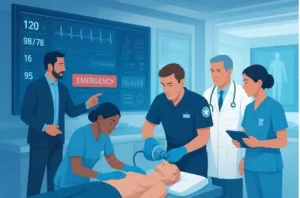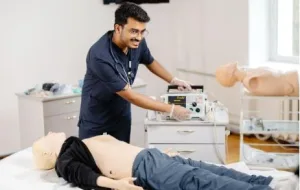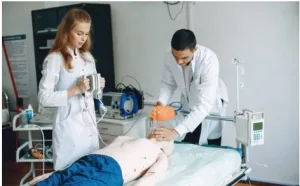
Healthcare emergency response training serves as the cornerstone for preparing hospital staff and healthcare responders to effectively manage critical incidents, including mass casualty incidents and disaster situations. In an environment where rapid, coordinated, and precise action is imperative, comprehensive training programs equip hospital emergency response teams with the essential skills, knowledge, and judgment needed to optimize patient outcomes under pressure.
These training programs center on enhancing capabilities in emergency medical response, triage, decontamination, and the use of personal protective equipment (PPE). Given the complexity and unpredictability of emergencies—ranging from chemical biological radiological nuclear explosive (CBRNE) threats to natural disasters—the role of advanced healthcare emergency response education cannot be overstated. The integration of frameworks such as the incident command system (ICS) and hospital incident command system (HICS) ensures that hospital emergency operations function efficiently within coordinated emergency response networks.
Renowned institutions, including the Center for Domestic Preparedness (CDP) and the University of Alabama School of Medicine (UASOM), contribute to the development and dissemination of such training, often aligning with standards set by organizations like the Accreditation Council for Continuing Medical Education (ACCME) and the Commission on Accreditation for Pre-Hospital Continuing Education (CAPCE). These programs often encompass operations level training that addresses both general and specialized competencies, including hazardous materials training and CBRNE response.
The Importance of Emergency Preparedness in Healthcare Settings
Emergency preparedness within healthcare settings is critical not only for managing sudden influxes of patients during mass casualty incidents but also for safeguarding hospital infrastructure, hospital staff, and the wider community. The dynamic nature of emergencies necessitates that hospital emergency plans are regularly updated and hospital emergency response teams are adept in executing them under challenging conditions.
Preparedness involves adherence to hospital safety requirements, including strict protocols on infection control, proper use of PPE, and patient processing. It also extends to ensuring hospital security personnel and environmental staff training are fully integrated into holistic emergency medical response strategies. For instance, managing patient contamination during a hazardous materials incident requires seamless coordination among healthcare responders, decontamination teams, and hospital emergency treatment areas.

Moreover, healthcare facility response capabilities must align with national standards such as those promulgated by FEMA (e.g., IS-100.c, IS-200.c, IS-700.b) which provide foundational knowledge of incident command and emergency management. These ensure hospital administrators and medical teams are aligned with the National Incident Management System (NIMS), thereby promoting interoperability with first responders and emergency medical services (EMS).
Key Components of Advanced Emergency Response Training Programs
Comprehensive Clinical and Operational Skill Building
Effective emergency response training programs for healthcare responders encompass a multifaceted curriculum designed to address both clinical skills and operational procedures. Core elements include:
- Mass Casualty Triage: Training in mass casualty triage, particularly with methods such as the SALT triage technique (Sort, Assess, Lifesaving Interventions, Treatment/Transport), prepares hospital emergency response teams to rapidly evaluate and prioritize patient care.
- Emergency Treatment Protocols: Curricula cover lifesaving interventions, resuscitation techniques, and emergency medical response essential for safe patient handling and optimal clinical outcomes.
- Decontamination Procedures: Specialized instruction in decontamination is vital for addressing patient contamination during CBRNE incidents, supporting safe transition of patients through emergency treatment areas.
- Personal Protective Equipment (PPE): Training emphasizes correct PPE usage to prevent injury or infection among hospital staff, reinforcing hospital safety requirements.
- Hospital Incident Command System (HICS): Incident command training educates staff on hierarchical roles and communication channels essential to hospital team operations and hospital emergency operations.
- Hazardous Materials and CBRNE Training: Operations level training in hazardous materials operations and CBRNE response, often aligned with OSHA 29 CFR 1910.120(q)(6)(ii), enhances readiness for complex disaster scenarios.
Certification and Continuing Education
Engagement with certified programs such as Hospital Emergency Response Training for Mass Casualty Incidents (HERT) ensures healthcare personnel attain recognized proficiency. Certifications often correlate with continuing education units (CEUs) to support ongoing professional development. These certifications include:
-
- Emergency medical response certification
- CPR training and CPR certification for healthcare providers, including adult CPR and pediatric advanced life support (PALS certification)
- AED training and AED certification
- Basic Life Support (BLS training and certification)
- Bloodborne pathogens training
- First aid training and renewal, accessible through platforms like Red Cross training or first aid classes online
Aligning these credentials with entities such as the International Association of Continuing Education and Training (IACET) guarantees that training adheres to rigorous educational standards.
Information contained on this page is provided by an independent third-party content provider. Binary News Network and this Site make no warranties or representations in connection therewith. If you are affiliated with this page and would like it removed please contact [email protected]




Comments